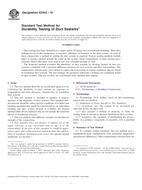Wir benötigen Ihre Einwilligung zur Verwendung der einzelnen Daten, damit Sie unter anderem Informationen zu Ihren Interessen einsehen können. Klicken Sie auf "OK", um Ihre Zustimmung zu erteilen.
ASTM G206-11
Standard Guide for Measuring the Wear Volumes of Piston Ring Segments Run against Flat Coupons in Reciprocating Wear Tests
Automatische name übersetzung:
Standard-Handbuch für die Messung der Verschleiß Volumes von Kolbenringsegmente laufen gegen Flach Coupons in Kolbenverschleißtests
NORM herausgegeben am 1.5.2011
Informationen über die Norm:
Bezeichnung normen: ASTM G206-11
Anmerkung: UNGÜLTIG
Ausgabedatum normen: 1.5.2011
SKU: NS-57601
Zahl der Seiten: 4
Gewicht ca.: 12 g (0.03 Pfund)
Land: Amerikanische technische Norm
Kategorie: Technische Normen ASTM
Kategorie - ähnliche Normen:
Die Annotation des Normtextes ASTM G206-11 :
Keywords:
cylinder liner, piston ring, wear measurement, Cylinder liner materials, Measurement processes/systems, Piston rings, Wear and wear life, ICS Number Code 21.140 (Seals, glands)
Ergänzende Informationen
| Significance and Use | ||||
|
The practical life of an internal combustion engine is most often determined by monitoring its oil consumption. Excessive oil consumption is cause for engine repair or replacement and can be symptomatic of excessive wear of the piston ring or the cylinder bore or both. More wear-resistant materials of construction can extend engine life and reduce cost of operation. Although components made from more wear-resistant materials can be tested in actual operating engines, such tests tend to be expensive and time consuming, and they often lead to variable results because of the difficulty in controlling the operating environment. Although bench-scale tests do not simulate every aspect of a fired engine, they are used for cost-effective initial screening of candidate materials and lubricants. The test parameters for those tests are selected by the investigator, but the end result is a pair of worn specimens whose degree of wear needs to be accurately measured. The use of curved specimens, like segments of crowned piston rings, presents challenges for precise wear measurement. Weight loss or linear measurements of lengths and widths of wear scars may not provide sufficient accuracy to discriminate between small differences in wear. This guide is intended to address that problem. |
||||
| 1. Scope | ||||
|
1.1 This guide covers and describes a profiling method for use accurately measuring the wear loss of compound-curved (crowned) piston ring specimens that run against flat counterfaces. It does not assume that the wear scars are ideally flat, as do some alternative measurement methods. Laboratory-scale wear tests have been used to evaluate the wear of materials, coatings, and surface treatments that are candidates for piston rings and cylinder liners in diesel engines or spark ignition engines. Various loads, temperatures, speeds, lubricants, and durations are used for such tests, but some of them use a curved piston ring segment as one sliding partner and a flat or curved specimen (simulating the cylinder liner) as its counterface. The goal of this guide is to provide more accurate wear measurements than alternative approaches involving weight loss or simply measuring the length and width of the wear marks. 1.2 This standard does not purport to address all of the safety concerns, if any, associated with its use. It is the responsibility of the user of this standard to establish appropriate safety and health practices and determine the applicability of regulatory limitations prior to use. |
||||
| 2. Referenced Documents | ||||
|
Ähnliche Normen:
Historisch
1.11.2011
Historisch
1.11.2007
Historisch
1.3.2010
Historisch
1.1.2013
Historisch
1.4.2011
Historisch
1.4.2010
Empfehlungen:
Aktualisierung der Gesetze
Wollen Sie sich sicher sein, dass Sie nur die gültigen technischen Vorschriften verwenden?
Wir bieten Ihnen Lösungen, damit Sie immer nur die gültigen (aktuellen) legislativen Vorschriften verwenden könnten.
Brauchen Sie mehr Informationen? Sehen Sie sich diese Seite an.



 ASTM D3832-79(2011)..
ASTM D3832-79(2011).. ASTM D3903-03(2007)..
ASTM D3903-03(2007).. ASTM E2342-10
ASTM E2342-10 ASTM E2750-13e1
ASTM E2750-13e1 ASTM F104-11
ASTM F104-11 ASTM F105-72(2010)..
ASTM F105-72(2010)..
 Cookies
Cookies
